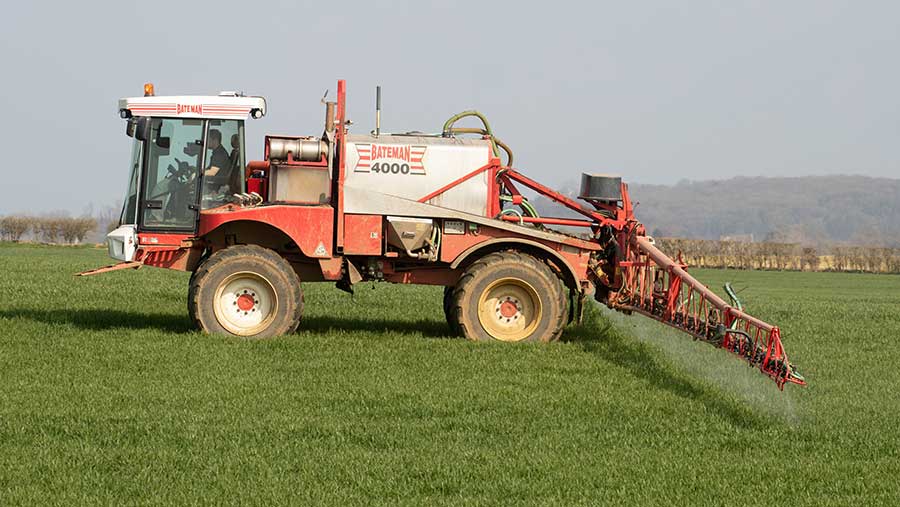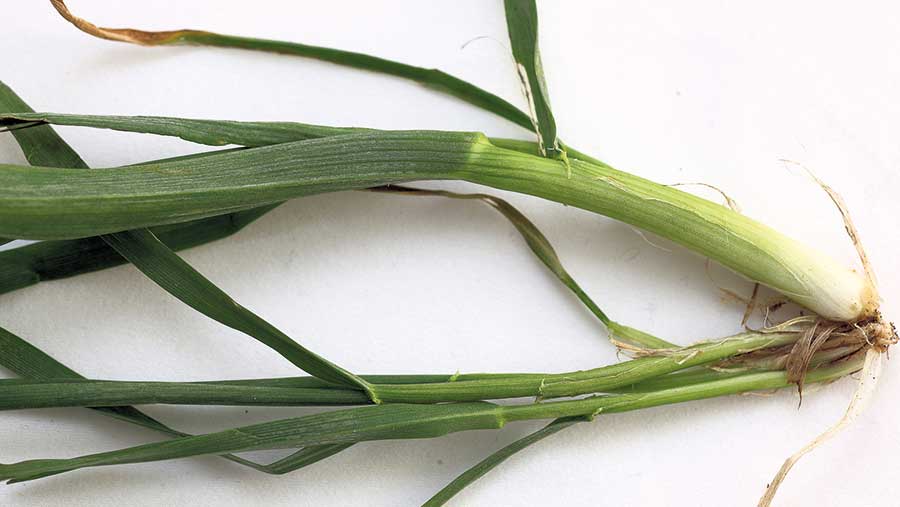Crop Watch: T0 spray plans being made for wheat and gout fly
 © Tim Scrivener
© Tim Scrivener While winter barley is the priority for early plant growth regulator and fungicide applications, agronomists are already refining plans for the T0 sprays in wheat.
For some, an elicitor product is being trialled instead of a multisite fungicide.
In the west, patches of clubroot are becoming evident in OSR while in the south, gout fly larvae are widespread in early drilled wheat and barley crops.
See more: Advice on controlling wheat disease as fungicide prices rise
North
Mary Munro
AICC/Strutt and Parker (Perthshire)
Spring is quietly creeping upon us in the Lothians this year, and we have had late snow (fortunately, not much of it) and now a week of rain.
Temperatures are only just beginning to lift a little, with the odd day in the teens.
Crops are not causing much concern yet. Wheats are generally well-tillered and reasonably clean, with some septoria evident, but very little yellow rust or mildew.
Most of my growers are aiming for the distilling market and growing soft wheats.
The varieties tend to be good for rust and mildew, but weaker on septoria which is always our main challenge.
Certainly since Leeds departed from the Recommended List, there has been nothing nearly so poor for mildew.
Some crops have had the first nitrogen (N) already, and I am now planning T0 and ordering product – for the most part, a simple dose of tebuconazole with some plant growth regulator and manganese.
I am tempted to try some Laminarin elicitor this season in a farm trial, to see if we can observe any differences at field level, and also to work out if it gives a better return than folpet.
Pigeon damage
Pigeons have only just moved into oilseed rape crops and hence damage levels are not as bad as usual.
These crops were established early into good seed-beds and have looked good all winter, which is a pleasant position to be in.
There is very little disease, and this is just as well, given the seemingly endless spend on herbicides.
We are trying to get clopyralid on for mayweed, groundsel and sow thistle before the cut-off, but rain has stopped play at a critical stage.
My team is dealing with a great demand for carbon audits at the moment, while the Scottish government is still paying for them.
Under the current arrangements, farmers who have done a carbon audit in the past three years can get funding for soil analysis if it includes soil carbon.
This will change in 2025 when there will be a requirement to have a carbon audit and soil analysis in order to claim BPS.
Despite the turmoil at Holyrood, I have every faith in the civil servants seeing their transition plan through to 2025.
West
Antony Wade
Hillhampton Technical Services (Heref/Shrops)
OSR crops are starting to move into stem extension. Luckily, there was a short window of opportunity in the first few days of March to apply herbicides where we have some final weeds to deal with.
Other crops that might have been done will have to be cancelled, as buds are now becoming exposed, so the damage risk outweighs the weed control advantage. We will have to rely on crop competition.
I have some crops with large green area indices which will get an application of Caryx (mepiquat + metconazole) as soon as we get a weather window, to reduce apical dominance and increase branching.
Samples sent to Adas for Bayer’s spotcheck initiative have shown light leaf spot present in most crops, so prothioconazole will be added to protect against further infection.
Patches of clubroot have started to become visible in the past couple of months even on farms where we are growing tolerant varieties such as Crossfit and Crome.
None of these were early-drilled as we know this increases risk of infection. These crops will get a phosphite foliar nutrient to try to help stimulate superficial rooting to mitigate against the impact of clubs on roots.
The good autumn drilling conditions and mild temperatures have resulted in most cereal crops looking well tillered with good leaf area.
Early harvest of maize and potatoes meant there were few late-drilled crops.
Winter barley crops are moving towards or past growth stage 30. Most have had their first fertiliser split, but need a second application as soon as ground conditions allow, as some are getting that yellow hungry look again.
Barley priority
Early plant growth regulator and fungicides are arguably more important on winter barley than other crops to keep tiller numbers and health, to ensure high ear numbers and maximise yield potential.
These T0 plans have been made, but if the unsettled weather continues, limiting spray opportunities this month, these recommendations may have to be revised to an early T1.
Rhynchosporium and net blotch are easily found on lower leaves, plus – surprisingly to me considering the frosty weeks we have had – some brown rust in some crops.
Mildew, however, has been notable by its absence.
In wheat, our familiar enemy septoria is developing on the lower leaves again across all varieties. I haven’t found any yellow rust in my crops, even on likely candidates such as Zyatt and Gleam.
But I have heard plenty of reports from fellow agronomists, in particular in Extase, which seems to counter its rating for this disease.
The lack of rust at the moment makes T0 decisions more difficult, but certain varieties will have to be covered on the assumption that it will erupt before T1.
On varieties where I am more confident on rust resistance, the elicitor Laminarin will be used as I have found that, for septoria, it gives as much control as any multisite alternatives.
Many strongly tillered crops will require some early plant growth regulator. Canopy (mepiquat + prohexadione) is my preferred choice at this early stage.
We managed to get some grassweed herbicide on in February; we will see if we get the control in cool conditions.
Although pre-emergence aclonifen and flufenacet herbicides have worked well, grassweeds are starting to show themselves, so when we get some settled weather Atlantis Star or Proverb (iodosulfuron + mesosulfuron + thiencarbazone) will be used where ryegrass is the main target.
For bromes it will be Pacifica Plus (amidosulfuron + iodosulfuron + mesosulfuron) and Broadway Star (florasulam + pyroxsulam) for wild oats and cleavers.
East
Marion Self
AICC/Prime Agriculture (Suffolk)
Early March roared in like the proverbial lion. Poor weather then paused play, but as field conditions improve, growers can complete outstanding jobs and continue through the early spring workload.
Delayed fertiliser, grassweed and manganese applications should take priority, then other activities associated with early spring growth can begin. It’s a busy time.
Winter wheats are in good condition as they utilise nitrogen and early-applied micronutrients.
September- and early to mid-October-drilled crops have reached or are approaching early stem extension.
These are now ready for fungicide, plant growth regulator and broad-leaved weed control applications as appropriate.
Cold conditions have kept yellow rust infection low, but continue to monitor crops and protect those with a high susceptibility to this disease.
Septoria infection is present on lower leaves and there are already visible differences in the severity of infection between varieties with different resistance ratings.
Winter barley
Winter barleys are pulling together although some are still pale and uneven as cold, wetter conditions have caused some variation due to soil type, nutrient availability and possibly viral infection.
Many barley crops also came through the winter carrying significant net blotch infections although the cold weather appears to have temporarily stalled this development.
As barley reaches stem extension it will also require early plant growth regulators (PGRs), fungicides and possibly herbicides.
Oilseed rape crops continue to remind us of the high risk associated with growing this crop.
Frequent frosts have exacerbated the damage from heavy cabbage stem flea beetle and rape winter stem weevil populations.
Because of this, some of the better crops can be found closer to the coast where conditions have been milder.
Better crops can be assessed for treatment with PGR, light leaf spot control and micronutrient top-ups such as boron and manganese.
However, before the level of input is agreed the crop must be judged according to its perceived yield potential and the likely return on investment. Will it be worth it?

Swollen wheat stem from gout fly larvae © Blackthorn Arable
South
Jamie Swift
Procam (East Sussex)
Spring has finally arrived in the south. Winter cereals are beginning to respond to the welcome spring weather, with growth stage 30 the next benchmark to look out for.
A robust T0 application will be justified in most situations as large, overwintered crops coming out of a drawn-out winter are harbouring high amounts of disease.
I’m advising that barley crops are treated as a priority as these early growth stages contribute considerably to overall yield.
Net blotch and mildew are not hard to find so a prothioconazole/strobilurin mix will be my go-to for the initial winter clean up.
Gout fly larvae, causing swollen stems, is widespread in early-drilled wheat and barley crops.
Although it is not generally a problem due to its inability to move between tillers, I am seeing more than I’m comfortable with.
This has spurred me on to make early nitrogen applications, with most cereal crops having recently had about 40kg/ha to maintain tillers numbers.
I’ll be monitoring N response rates throughout the spring using my leaf N-tester – a valuable tool that gives an in-field indication of crop uptake and nitrogen requirements going forward.
OSR disease
Oilseed rape crops look full of potential, having come through the winter largely unscathed by pigeon and flea beetle attack.
Inevitably, crops are now showing signs of disease, especially those that have large canopies, with light leaf spot and phoma the main culprits currently.
Green area index (GAI) is directly linked to yield, so canopy management needs to be factored in when decision-making at this point in the season.
In OSR, the crop contains about 50kg/ha of nitrogen for each unit of GAI, highlighting the importance of a well-managed spring canopy.
Fungicides with plant growth regulatory activity will be used to maintain canopy structure and I will be selecting metconazole-containing products in most instances.

